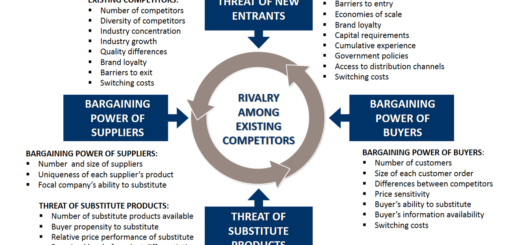Strategic Group Analysis
Strategic groups are organizations within an industry or sector with similar strategic characteristics, following similar strategies or competing on similar bases. Companies within a strategic group compete with each other directly because they offer similar products or services to the same customer segments.
- These characteristics are different from those of other strategic groups in the same industry or sector
- There are many different characteristics that distinguish between strategic groups
- Strategic groups can be mapped onto two-dimensional charts – maps. These can be useful tools for analysis

Strategic groups are typically identified by analyzing the following factors:
- Similarity of products or services: Companies that offer similar products or services to the same customer segments are likely to belong to the same strategic group.
- Similarity of marketing strategy: Companies that use similar marketing strategies to target the same customer segments are also likely to belong to the same strategic group.
- Similarity of competitive strategy: Companies that use similar competitive strategies, such as pricing or differentiation, are likely to belong to the same strategic group.
- Similarity of distribution channels: Companies that use similar distribution channels to reach customers are also likely to belong to the same strategic group.
Understanding the strategic groups within an industry can be useful for companies in developing their own strategies. Companies can use this information to identify the strengths and weaknesses of their competitors and to determine their own competitive positioning within the industry. Additionally, identifying strategic groups can help companies anticipate changes in the competitive environment and adjust their strategies accordingly.
Purpose of Strategic Group Analysis
Strategic Group Analysis is a framework used to analyze the competitive landscape of an industry by grouping companies with similar strategic characteristics. It is used to determine the following:
- Industry structure: Strategic Group Analysis helps in identifying the structure of the industry by categorizing companies into different strategic groups based on their similarities in terms of product offerings, market positioning, and other strategic variables.
- Competitive dynamics: By analyzing the competitive dynamics of different strategic groups, companies can understand how intense competition is within their group and how to compete with other groups. This analysis helps companies to develop effective competitive strategies and make informed decisions about where to focus their resources.
- Industry trends: Strategic Group Analysis helps in identifying industry trends by examining the strategic behavior of different groups. Companies can use this analysis to identify emerging trends, opportunities, and threats in the industry and adapt their strategies accordingly.
- Potential for strategic alliances: Companies can use Strategic Group Analysis to identify potential partners for strategic alliances. By analyzing the strategic groups in the industry, companies can identify other groups with complementary strengths and capabilities, which can help them to form strategic partnerships and gain a competitive advantage.
Overall, Strategic Group Analysis is a useful tool for companies to gain a better understanding of the competitive landscape of their industry and develop effective strategies to compete and succeed in the market.
Different Stages of Strategic Group Analysis
There are several stages involved in conducting a strategic group analysis. The key stages include:
- Identify the industry: The first step in conducting a strategic group analysis is to clearly define the industry or market being studied. This involves identifying the products or services being offered, the target customers, and the key competitors.
- Identify the strategic dimensions: The next step is to identify the strategic dimensions that will be used to distinguish between the different strategic groups within the industry. Examples of strategic dimensions could include product quality, pricing strategy, distribution channels, and geographic reach.
- Identify the strategic groups: Once the strategic dimensions have been identified, the next step is to group the competitors into strategic groups based on their similarities and differences across these dimensions. This involves identifying the key competitors within the industry and comparing their strategic characteristics to determine which groups they belong to.
- Analyze the groups: Once the strategic groups have been identified, the next step is to analyze their performance and competitive dynamics. This involves assessing the strengths and weaknesses of each group, as well as their market positions and competitive strategies.
- Identify the implications: The final step in conducting a strategic group analysis is to identify the implications for the company or companies conducting the analysis. This involves using the insights gained from the analysis to inform strategic decision-making, such as identifying potential acquisition targets or developing new competitive strategies to better compete within the industry.




